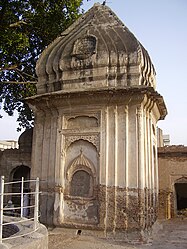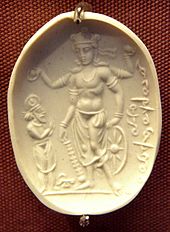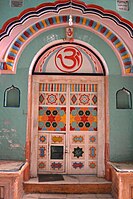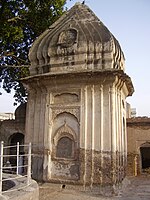Hinduism in Khyber Pakhtunkhwa
 Gorakhnath Temple in Khyber Pakhtunkhwa. | |
| Total population | |
|---|---|
| 6,373 (2017) 0.018% of region population | |
| Religions | |
| Hinduism (majority) including Nanakpanthi, Kalasha and Animists | |
| Languages | |
| Sanskrit (Sacred) Urdu, Pashto, Punjabi |
Hinduism is a minority religion in Khyber Pakhtunkhwa followed by 0.02% of the population of the province as per 2017 Census. Though being in very less numbers and very less presence, the history of Khyber Pakhtunkhwa had a very significance of Hindu culture.
History[]

The Gandharan civilization features prominently in the Hindu epic poem, the Mahabharatha,[2] The Vedic texts refer to the area as the province of Pushkalavati. The area was once known to be a great center of learning.[3]
In the first millennium CE, the Khyber Pakhtunkhwa region was ruled by Hindu-Buddhist Shahi kings. During the rule of the Shahis, the Khyber Pakhtunkhwa region was a center of trade. Textiles, gems, and perfumes, as well as other goods had been exported West and into Central Asia. The Shahis were known for their many Hindu temples. These temples were mostly looted and destroyed by later invaders. The ruins of these temples can be found at Nandana, Malot, Siv Ganga, and Ketas, as well as across the west bank of the Indus river.[4][5]At the height of Shahi rule under King Jayapala, the kingdom had extended to Kabul and Bajaur to the Northwest, Multan to the South, and the India-Pakistan border to the East.[4] Jayapala, threatened from the consolidation of power by the kingdom of Ghazna, invaded their capital city of Ghazni. This had initiated the Muslim Ghaznavid and Hindu Shahi struggles.[6] Over time, Mahmud of Ghazni had pushed further into the subcontinent, as far as east as modern day Agra. During his campaigns, many Hindu temples and Buddhist monasteries had been looted and destroyed, as well as many people being forcibly converted into Islam.[7] Local Pashtun and Dardic tribes converted to Islam, while retaining some of the pre-Islamic Hindu-Buddhist and Animist local traditions such as Pashtunwali.[8]
Immediately prior to 1947 Partition of India, the British held a referendum in the NWFP to allow voters to choose between joining India or Pakistan and 99.02% votes were cast in favor of Pakistan.[9] After the independence of Pakistan in 1947, most of the Hindus left for India.[10]
Demographics[]
According to the 1998 Census, there are 5,090 Hindus (including the Scheduled Castes) constituting 0.029% of the population of Khyber Pakhtunkhwa.[11] In the 2017 Census, there were 5392 Hindus constitutes 0.015% of the population.[12] However, Pakistan Hindu Council estimates that there are 21,033 Hindus in Khyber Pakhtunkhwa.[13]
Community Life[]
In Peshawar, capital of Khyber Pakhtunkhwa, Hindus enjoy religious freedom and live peacefully alongside the Muslims. The city of Peshawar today is home to four Hindu tribes– the Balmiks, the Rajputs, the Heer Ratan Raths and the Bhai Joga Singh Gurdwara community. Since partition, the four tribes have lived in harmony with all religious communities including Muslims. However, there is the lack of upkeep of the dilapidated Hindu temples in the city. The local government always fails to assign caretakers and priests at temples.[14] But in other parts of Khyber Pakhtunkhwa like Buner, Swat and Aurakzai Agencies, Hindu and Sikh families, have been targeted by Taliban for failing to pay Jizya (religious tax) and due to this more than 150 Sikhs and Hindu families in Pakistan's have moved to Hasan Abdal and Rawalpindi in Punjab in 2009.[15]
The Kalasha people practice an ancient form of Hinduism mixed with animism.[16][17] They are considered as a separate ethnic religion people by the government of Pakistan.[18] They reside in the Chitral District of Khyber-Pakhtunkhwa province.[19]
Mansehra Shiv Temple is one of the oldest Hindu temple in Pakistan that is still in existence. It is at least 2000[20] to 3000 years old.[21] is another historic hindu temple in Pakistan.[22][23] In 2020 Karak temple attack, historic Hindu temple and Samadhi in Karak district was vandalised and burnt by a mob of 1,500 local Muslims led by a local Islamic cleric and the supporters of Jamiat Ulema-e-Islam party.[24][25]
Temple[]
See also[]
- Hinduism in Sindh province
- Hinduism in Balochistan
- Hinduism in Punjab Province
References[]
- ^ Buddhism in Central Asia by Baij Nath Puri p.131
- ^ "Imperial Gazetteer2 of India, Volume 19, page 148 – Imperial Gazetteer of India – Digital South Asia Library". Retrieved 4 June 2021.
- ^ Bhattacharya, Avijeet. Journeys on the Silk Road Through Ages. Zorba. p. 187.
- ^ Jump up to: a b (Wynbrandt, pp. 52–54)
- ^ (Wink, p. 125)
- ^ (Holt et al 1977, p. 3)
- ^ (Wynbrandt 2009, pp. 52–55)
- ^ (Tomsen 2013, p. 56)
- ^ Jeffrey J. Roberts (2003). The Origins of Conflict in Afghanistan. Greenwood Publishing Group. pp. 108–109. ISBN 9780275978785. Retrieved 18 April 2015.
- ^ Zamindar, Vazira Fazila-Yacoobali (2010). The Long Partition and the Making of Modern South Asia: Refugees, Boundaries, Histories. Columbia University Press. pp. 40. ISBN 978-0-231-13847-5.
- ^ "Population Distribution by Religion, 1998 Census" (PDF). Pakistan Bureau of Statistics. Archived (PDF) from the original on 24 May 2021. Retrieved 4 June 2021.
- ^ "SALIENT FEATURES OF FINAL RESULTS CENSUS-2017" (PDF). Retrieved 4 June 2021.
- ^ "Hindu Population (PK) – Pakistan Hindu Council". Archived from the original on 4 June 2021. Retrieved 24 May 2021.
- ^ "Across religious divides: A harmonious haven for Hindus in Khyber-Pakhtunkhwa". The Express Tribune. 14 October 2019.
- ^ "Sikhs and Hindu families move to Pak Punjab". NDTV. 3 May 2009.
- ^ Witzel, Michael (2004), "Kalash Religion (extract from 'The Ṛgvedic Religious System and its Central Asian and Hindukush Antecedents')" (PDF), in A. Griffiths; J. E. M. Houben (eds.), The Vedas: Texts, Language and Ritual, Groningen: Forsten, pp. 581–636
- ^ pace Fussman 1977
- ^ Akbar, Ali (4 April 2017). "Peshawar High Court orders govt to include Kalasha religion in census". Dawn. Retrieved 11 July 2017.
Kalasha, the religion followed by Kalash community, lies between Islam and an ancient form of Hinduism.
- ^ Lazaridis, Iosif; Nadel, Dani; Rollefson, Gary; Merrett, Deborah C.; Rohland, Nadin; Mallick, Swapan; Fernandes, Daniel; Novak, Mario; Gamarra, Beatriz; Sirak, Kendra; Connell, Sarah (2016h). "Genomic insights into the origin of farming in the ancient Near East". Nature. 536 (7617): 419–424. Bibcode:2016Natur.536..419L. doi:10.1038/nature19310. ISSN 1476-4687. PMC 5003663. PMID 27459054.
- ^ "Pakistan prepares to hold a major Hindu festival Maha Shivaratri". Asia. Gulf News. TNN. 17 February 2020. Retrieved 4 June 2021.
- ^ "Mansehra's Shiv temple". Fridaytimes. TNN. 14 August 2014. Retrieved 4 June 2021.
- ^ "Panj Tirath: Heritage Lost to the Ravages of Time". The Friday Times. 2019-02-15. Retrieved 2021-06-06.
- ^ Scroll Staff. "Pakistan declares ancient Hindu religious site Panj Tirath to be national heritage". Scroll.in.
- ^ "Pakistan arrests more than a dozen over Hindu temple attack". Aljazeera. 31 December 2020. Retrieved 4 June 2021.
- ^ Imtiaz Ahmad (31 December 2020). "Hindu temple in Pakistan vandalised, set on fire". Hindustan Times. Retrieved 4 June 2021.
External links[]
- Hinduism in Khyber Pakhtunkhwa
- Hinduism in Pakistan by administrative unit
- Religion in Khyber Pakhtunkhwa


